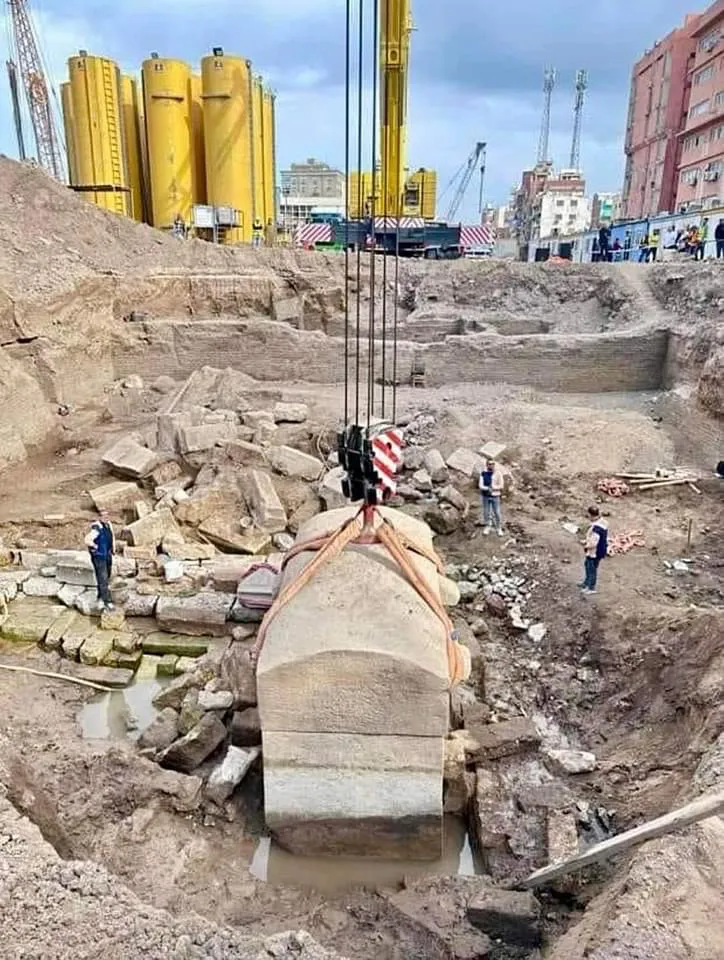In a remarkable archaeological find, a 26th Dynasty sarcophagus has been unearthed at a construction site for the new Benha University Hospital in the Delta town of Banha, located in the Qalyoubiya Governorate of Egypt. This discovery was made during rescue excavations, a common practice in regions with rich historical layers beneath the modern landscape. The Supreme Council of Antiquities (SCA) in Egypt has taken charge of the situation, announcing the find and outlining the steps being taken to preserve this significant piece of history.
Get your dose of History via Email
The Sarcophagus and Its Historical Context
The sarcophagus, made of quartzite, dates back to the reign of King Psamtik I, a ruler of the 26th Dynasty. This period is noted for its attempts at revitalizing the power and glory of ancient Egypt by restoring its temples and reclaiming territories once lost. The sarcophagus itself is a massive structure, weighing approximately 62 tons, including its lid. This discovery is not just significant due to its size but also because of the historical insights it offers. Preliminary studies of the engravings and reliefs on the sarcophagus suggest that it belonged to a high-ranking official, specifically the overseer of the scribes during King Psamtik I’s reign. This is evidenced by an engraved relief found beneath the lid, portraying King Psamtik I, which adds a personal dimension to the historical narrative of the 26th Dynasty.
The Excavation and Restoration Process
The discovery was made during the course of rescue excavations at the site designated for the construction of the Benha University Hospital. Recognizing the importance of the find, the SCA initiated a careful process to relocate the sarcophagus for restoration. Mustafa Waziri, the Secretary-General of the SCA, highlighted the meticulous scientific protocols followed in lifting and transporting this ancient artifact. A specialized team from the SCA and the Grand Egyptian Museum (GEM) was involved in preliminary restoration tasks at the excavation site. These tasks included mechanical cleaning and reinforcing both the sarcophagus and its lid to ensure its preservation.
Following these initial steps, the sarcophagus is slated for transfer to the Qalyoubiya Antiquities area, where it will undergo thorough maintenance and restoration procedures. This careful and scientific approach underscores the importance of preserving such discoveries for future generations and the wealth of knowledge they hold.
The Significance of the Discovery
The unearthing of this sarcophagus is a testament to Egypt’s rich and multifaceted history. Each discovery like this provides invaluable insights into the lives, beliefs, and societal structures of ancient civilizations. The fact that this sarcophagus was found in a construction site also highlights the challenges and opportunities of conducting archaeology in a land as historically dense as Egypt. The ongoing commitment of the SCA to rescue excavations ensures that even as the country moves forward in development, its ancient heritage is not forgotten but rather integrated into the narrative of progress.
The discovery of the 62-ton sarcophagus in Banha is a significant addition to our understanding of the 26th Dynasty and the reign of King Psamtik I. As restoration efforts continue, it is hoped that further studies will reveal more about the individual to whom this sarcophagus belonged, shedding light on the intricacies of ancient Egyptian society and governance. This find not only adds a new chapter to Egypt’s ancient history but also reinforces the importance of archaeological vigilance in preserving our shared human heritage.
Sources: https://english.ahram.org.eg/News/518767.aspx
Photos: Facebook Post and another Facebook Post


Woo hoo! Love it when they make new finds. Can’t wait to see what’s inside.
With those protruding knobs on the top casing stone. Reminds me of of others ancient sites throughout the world.
Some of the ancient sites are of pre history construction. 13,000 bc 10,000 bc.
So their new ancient discovery goes back in time to the original ceeaters ot the Spinx and the 3 pyramids bind the Spinx.
Wow we grearfully accepts the bright cultural past of Egypt. Also world scholars must help to evaluate the findings.